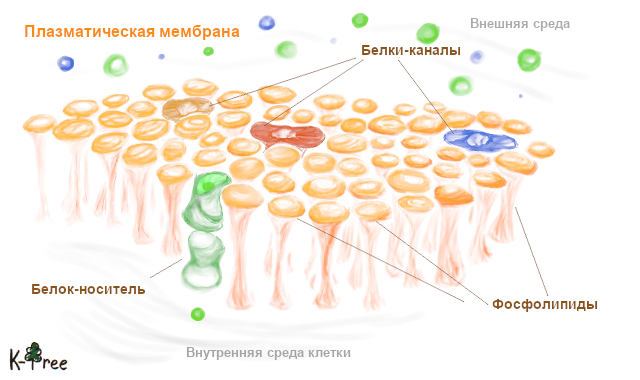Liquid mosaic model
The liquid mosaic model implies the composition of the plasma membrane from two rows of phospholipids with multiple inclusions of proteins. Located on the inner and outer surfaces are called peripheral proteins, located inside the layer are integral proteins. Sometimes carbohydrates are added to proteins and fats, which in total they form glycoproteins and glycolipids, respectively.
Some membranes include cholesterol molecules. A small amount of mitochondrial membranes, while how some membranes are half made up of cholesterol. Cholesterol provides greater variability and strength phospholipid layer, but reduces the amount of passing liquids soluble in water.
A large number of proteins in the phospholipid layer forms a protein mosaic. Some of the boundary proteins are involved in the movement of substances through the membrane, therefore they are called transport proteins. Transport proteins there are two types - protein channels that form pores, and carrier proteins that carry substances through the membrane.All cell membranes, including organelle membranes such as the nucleus, reticules, Golgi apparatus, mitochondria, lysosomes and chloroplasts, have the same basic structure, only the amount of fats, proteins and carbohydrates changes.
Metabolism
The vital activity of the cell implies the exchange of substances with the environment, like nutrition - the cell absorbs new substances and releases "waste". There are passive and active transport.
Passive transport
In the case of passive transport, the cell does not expend energy for the transfer of substances, substances move at the expense of their own kinetic energy.
Diffusion
Diffusion occurs due to the movement of substances from areas with a higher concentration to places with a lower concentration. For example, if you add a drop of dye to water, the drop will dissolve in the entire volume, this is due to the tendency to decrease the internal energy of the substance (these processes are described in more detail in the article thermodynamics).
Osmosis
Osmosis of a cell is the process of water diffusion. The cell cannot control the osmosis process and the amount of water in the cell depends on the concentration of water in the medium. If the concentration of water molecules in the medium is higher, then an excess of water is formed in the cell, which leads to increased internal pressure (hypotension), a tense state of the cell walls it is called turgor of tissues (Latin turgor - swelling). A reduced concentration of medium molecules leads to the opposite the process - the water comes out of the cell, the cell dries up.
Light diffusion
A lot of substances necessary for the existence of the cell cannot get through the plasma membrane, regardless of from pressure, since they are insoluble in fats (ions K+, Na+, Ca2+, monosaccharide, amino acids). For these purposes, channel proteins and carrier proteins are located in the membrane. Channel proteins form a passage like a pipe through a membrane that allows a certain type of substances to pass through. Carrier proteins they are open from the outside of the membrane and when certain substances enter the cavity of these proteins, they change their direction, moving the substance into the internal environment of the cell. Carrier proteins react very subtly to substances and do not allow pass even close to similar substances.
Active transport
In some cases, the cell needs to get rid of substances whose concentration inside the cell is less than outside, then the mechanism of active transport is activated. To move a substance from an area with a lower concentration to an area more concentration is necessary to expend energy, cells use the energy of ATP molecules (adenosine triphosphate). For active transport, a type of protein is used that has the ability to form a bond with an ATP molecule and the proteins are transported by the agent, they work in the mode of carrier proteins.
Vesicles
In addition to active and passive transport, the cell membrane also provides absorption of large particles, liquid and solid, this process is called endocytosis. Absorption of solid particles is called phagocytosis, liquid particles - pinocytosis. The cell surrounds a part of the medium with a plasma membrane, thus creating a cavity inside its body, which is called vesicle. Exocytosis occurs in a similar way: a vesicle comes out of the Golgi apparatus, and when in contact with the plasma membrane, it becomes part of it, releasing the contents into the external environment. In the process of exocytosis, waste products of the cell are released, or a substance secreted by the cell, for example, hormones.

